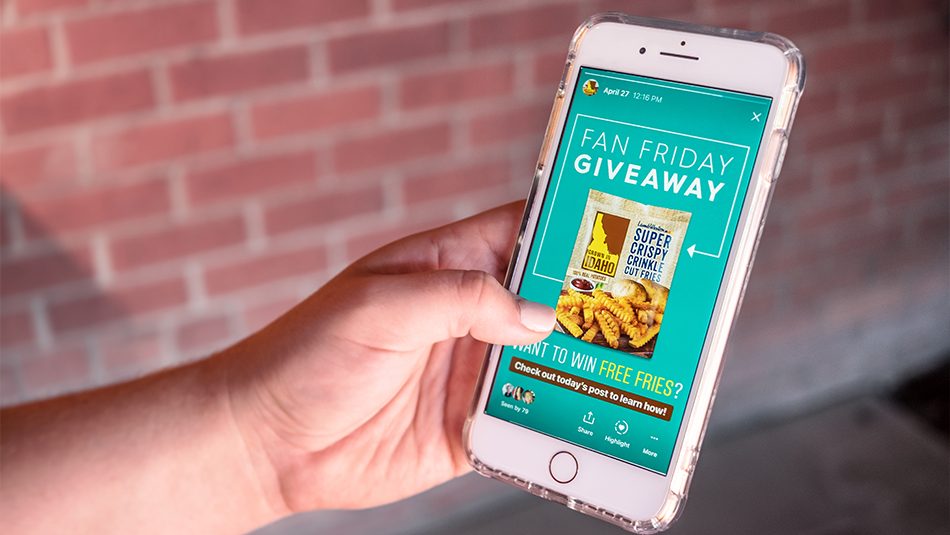
Why Food & CPG Brands Should be Using Instagram Stories
If you find it hard to keep up with the latest in social media, you’re not alone. Social trends, strategies, and standards move lightning-fast, but as a food brand in this space, rest assured — not all bandwagons are worth jumping on. Truthfully, unless your key demographic is Gen Z’ers, it’s often prudent for a brand to sit back and see which trends have staying power before investing your team’s time and financial resources into executing on a new digital marketing or social media strategy. With that said, if you haven’t already, the time has come to add short-form storytelling to your social media toolkit.
Instagram released their answer to Snapchat in August 2016 with the Stories feature — vertical videos and images which disappear after 24 hours. Facebook followed suit shortly after, releasing the same feature on their platform, but its adoption has been far lower than Instagram’s. In fact, Instagram’s more than 800M users have so fully embraced Stories that they surpassed Snapchat’s daily average users less than a year after launching, abruptly halting the once “It” platform’s growth in popularity.
Still not sure if Instagram Stories is a fit for your food brand? Consider this: Over 30% of Instagram’s users are creating and viewing videos via Stories. Not only that, but due to the feed’s algorithm, up to 70% of traditional Instagram posts may be going unseen. Posting and advertising in Stories is one way to outsmart the algorithm and make sure you’re reaching your audience where they’re currently consuming content. Perhaps the most compelling argument for giving Stories a try is, Why not? The fact that Stories are fleeting gives brands the freedom to experiment with content in a way that posting to a profile doesn’t always allow.
If you’re ready to breathe new life into your Instagram strategy, make sure you’re building your food brand’s Stories strategy with these key benefits in mind.
Stories Bring Transparency to Brands
From the user’s perspective, Stories is an attractive medium because of its authenticity factor. Whether it’s a brand or an individual telling the Story, this feature is meant to be used for in-the-moment video and photo content, like you’re taking the viewer along with you on your day. As brands enter this space, it’s important not to lose that essence of the tool. Your food brand’s Stories can give your audience a peek behind the curtain and lend a more natural voice to your social media presence.
Daily Harvest let their followers in on the happenings at HQ recently by chronicling a staff guacamole-making contest. Even though this content makes no mention of Daily Harvests’ products or service, they’re reinforcing the brand throughout, showing their personality, and reminding customers that there’s a whole team of people working to deliver their product.

With consumer trust in the food industry low, transparency can go a long way toward establishing confidence and preference for your food brand. Whether it’s going live with an industry expert, chronicling your trip to the latest food show, or going behind the scenes of your growing and manufacturing processes, find a way that your customers can make a human connection with your product.
Kroger has been using social media to support its larger Zero Hunger Zero Waste initiative in a variety of way across all platforms, but at the recent Natural Products Expo West 2018 show, they used Stories to put that plan into action. Rather than letting food go to waste, they challenged chefs to create meals out of products that would normally not meet standards to sell in-store and documented one chef’s process.

Generate Excitement with Stories
One big way Stories is changing the social media strategy game for brands is by giving them a way to jump into daily conversations on Instagram while still staying on-message. Since it disappears after a day, you can push out timely content through Stories while keeping your profile a highly-curated gallery that best represents your brand over time.
This presents the opportunity for brands to support larger marketing initiatives without overwhelming their followers’ feeds. Since you can upload pre-shot images and videos into your Stories, there’s no limit to how creative you can get in this arena. If you’re preparing to launch a new product or flavor, craft a Story to tell the journey of how it came to be so that the viewer is now emotionally invested in its launch. Or maybe your Stories countdown to a significant time of year for your brand, like apple picking season or National Coffee Day. If your messaging for 2018 is all about your product’s versatility, show how many different meal occasions it can fit into through a series of usage suggestions in a Story.
Shake Shack took this timely approach last month to announce their presence at Coachella. In one quick series, they made an announcement, gave a behind-the-scenes look at the festival setup, slyly called out for festival-goers to post about them during the event, generated excitement about their menu options, and left viewers wanting more with a cliffhanger. In the days leading up to the big event, they posted additional Stories diving deeper into the festival menu offerings and keeping the hype up for the second week of the festival, too.

On the other hand, Whole Foods proves brands don’t have to have a big announcement or event on the horizon in order to create some buzz through Stories. The health foods giant uses Stories on a regular basis to shout out new products in stock and ties in an easy CTA to drive traffic to their website.

Support Your Social Media Objectives
While it may seem like Stories is just a fun new way to get creative in the social space, don’t overlook the conversion power it holds. For business accounts that are verified or have more than 10K followers, Instagram allows a “Swipe up” directive that links out to any URL—a great alternative to the cumbersome “link in bio” method most users are stuck with. Brands with smaller followings can still use a strong call to action in Stories, though, since there is a direct messaging feature baked right into the tool, eliminating the need for current or future customers to navigate away from the content in order to reach out.
Another way Stories can make your ad efforts work harder for you is by advertising directly in Stories. Instagram introduced the ability to place ads within Stories last year, and when done right, they can be the most effective form of native marketing in the social space today. This is due in large part to the way Stories are served to the user in a continuous format, one playing right after the other with ads integrated seamlessly between friends’ Stories.
Content that speaks the language of the platform has the best chance of performing well, and The North Face figured out the perfect formula for blending the social media tone of voice with a clear call to action in this ad Story. Playing on Internet culture with the nod to dating apps in the ad copy, they invite viewers in a subtle, not showy, way to make a move by “matching” with their product.

Just Jump In
Ultimately, the key to social media success for your food brand is to keep your strategy nimble enough to evolve with the medium. And with a target audience that’s getting savvier to the tricks of traditional marketing all the time, humanizing your brand can go a long way toward customer loyalty. Jumping into the Instagram Stories space will show your audience you’re evolving alongside the culture and help you meet your marketing goals through storytelling.
In the spectrum of social media platforms, Instagram’s visual nature makes it the most friendly to food brands and appetite appeal, so make Stories an organic extension of your Instagram strategy. If you’re still not sure how to get started, I’ll leave you with this challenge: For the next recipe on your content calendar, post an accompanying Story that lays out the steps, too! It’s as simple as that.





